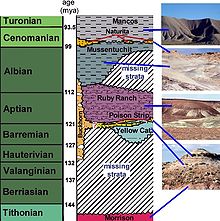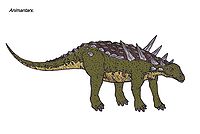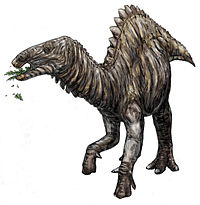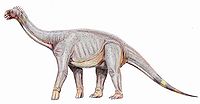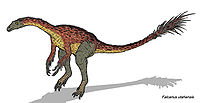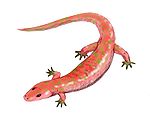- Cedar Mountain Formation
-
Cedar Mountain Formation
Stratigraphic range: Late CretaceousType Geological formation Location Region North America The Cedar Mountain Formation is the name given to distinctive sedimentary rocks in eastern Utah that occur between the underlying Morrison Formation and overlying Naturita Formation (sometimes incorrectly called the Dakota Formation). It is composed of non-marine sediments, that is, sediments deposited in rivers, lakes and on flood plains. Based on various fossils and radiometric dates, the Cedar Mountain Formation was deposited during the last half of the Early Cretaceous, about 127 - 98 million years ago (mya).
Dinosaurs occur throughout the formation, but their study has only occurred since the early 1990s. The dinosaurs in the lower part of the formation differ from those in the upper part. These two dinosaur assemblages, characterized by distinct dinosaurs, show the replacement of older, European-like dinosaurs with younger, Asian-like dinosaurs as the North American Continental Plate drifted westward. A middle dinosaur assemblage may be present, but the fossil record is not clear.
The formation was named for Cedar Mountain in northern Emery County, Utah, where William Lee Stokes first studied the exposures in 1944.[1] Only recently did the 125 m (410 ft) thick formation get subdivided into smaller, distinctive beds called members. There is a debate as to whether there are five members[2] or four[3] depending whether the Buckhorn Conglomerate is considered to be at the top of the Morrison Formation or at the base of the Cedar Mountain Formation; most geologists and paleontologist consider it part of the Cedar Mountain Formation. In ascending order the remaining members are the Yellow Cat Member, Poison Strip Sandstone, Ruby Ranch Member, and the Mussentuchit Member. Each of these members are named after a geographic area where they were first studied.
Contents
Stratigraphy
The Cedar Mountain Formation is sandwiched between the Morrison Formation below and the Naturita Formation and Mancos Shale above. The youngest date for Morrison just below the Cedar Mountain Formation is 148.1 ± 0.5 Ma .[4] or lower Tithonian. Typically, the Jurassic-Cretaceous boundary in western North America is marked by an unconformity of variable length, and typically signifies 10-49 million years of missing geologic time.[4] This boundary between the Morrison and Cedar Mountain is commonly marked by a horizon of carbonate nodules[5][6] or by highly polished pebbles that are allegedly gastroliths.
- The Buckhorn Conglomerate is considered the lowermost member of the Cedar Mountain Formation in the region of the San Raphael Swell by Stokes.[5] It is named for exposures near Buckhorn Reservoir near Cedar Mountain. Its position immediately below the Ruby Ranch Member suggests that it may be equivalent to the channel sandstones in the Yellow Cat Member and the Poison Strip Sandstone farther to the east. This idea is strengthened by the similar composition of the gravels in these members, but a direct correlation has not yet been established.
- The Yellow Cat Member is named for exposures near the Yellow Cat mining area north of Arches National Park. It is limited to the eastern portions of the formation and is thickest near Arches National Monument. The member is composed of drab greyish mudstones and some lenses of sandstone. The mudstones were deposited on flood plains, and show evidence of ancient soil development called paleosols. The mudstones originated as flood deposits from river channels that are marked by the sandstone lenses. A recent radiometric date of 126 ± 2.5 Ma places Yellow Cat Member in the Barremian,[7][2]
- The Poison Strip Sandstone was named for prominent, cliff-forming sandstones in the Poison Strip uranium district north of Arches National Monument. It is actually a series of sandstones that were deposited in river channels, and lesser amounts of mudstones and limestones that were deposited on the flood plain and small ponds. The Poison Strip Sandstone may represent a meandering river complex.[8] Based on the position of the Poison Strip between the Yellow Cat and Ruby Ranch members, it probably was latest Barremian to earliest Aptian.
- Volunteers from the Denver Museum of Natural History discovered Tony's Bone Bed in 1998 in the Poison Strip Member.[9] Prior to that, Posion Strip dinosaurs were only known from possible Sauropelta and isolated theropod and sauropod bones.[10] Tony's bone bed is 3.75 m below the top of the poison strip.[8] Quality of the bones are "highly variable."[11] Ends of bones may have been damaged by scavenging.[11] Some of the bones may have been trampled.[11] Some of the vertebrae preserve "delicate lamina".[11] None of the bones were articulated so the was probably not buried quickly after death.[11] Tony's Bonebed probably accumulated over time when the water in the river channel was low during the dry season.[11] Carbonate growths appear on bones in the quarry from which Venenosaurus was extracted.[12]
- The Ruby Ranch Member is the most widespread and distinctive member of the Cedar Mountain. It was named for exposures on the Ruby Ranch located southeast of Green River, Utah. The member is composed of maroon mudstones with irregular spheres of carbonate nodules. The nodules formed in ancient soils that developed in the mud deposited on the flood plain in a strongly seasonal, semiarid climate. Evaporation of groundwater during the dry season concentrated calcium carbonate and other minerals in the upper parts of the soil horizon. Radiometric dates place the upper portions of the Ruby Ranch in the late Aptian. Exhumed river channels in the Ruby Ranch indicate that stream flow during the Aptian was towards the northeast, the direction of the encrouching Western Interior Seaway.
- The Mussentuchit Member is the uppermost member of the Cedar Mountain Formation. It was named for exposures along Mussentuchit Wash southwest of the San Rafael Swell. It is predominantly composed of grey mudstones high in organic carbon from fossil plant material, as well as volcanic ash. The mudstones were originally deposited on a broad coastal plain with a high water table or with abundant rainfall. Thus, carbonate nodules are rare. A radiometric date of 98.37 ± 0.07 Ma places the upper part of the member in the Lower Cenomanian, while lower portions of the member have been dated to 104.46 ± 0.95 Ma, in the Albian stage.[13]
- Although not part of the Cedar Mountain Formation, the Naturita Formation immediately overlies the Cedar Mountain and marks the encroaching Western Interior Seaway. The Naturita is not uniformly distributed and was eroded away in places by the advancing Seaway so that the marine shales of the Mancos Formation lay directly on the Mussentuchit or its equivalent. The name Dakota Formation has been improperly used for these strata.
Dinosaurs
Example of dinosaurs from the Cedar Mountain Formation include the polacanthid ankylosaur Gastonia from the Yellow Cat Member (upper left), Utahraptor from the Yellow Cat Member (upper right), a large theropod represented by a tooth from the Ruby Ranch Member (lower left), and Tenontosaurus from the base of the Mussentuchit (lower right).
The Cedar Mountain Formation is one of the last major dinosaur-bearing formations to be studied in the United States. Although sporadic bone fragments were known prior to 1990, serious research did not begin until that year. Since then, several organizations have conducted field work collecting dinosaurs, chiefly the Oklahoma Museum of Natural History, the Denver Museum of Nature & Science, the College of Eastern Utah, the Utah Geological Survey, Brigham Young University, and Dinosaur National Monument staff. This research indicates that at least two, possibly three dinosaur assemblages are contained within the formation.
The oldest of these assemblages is from the Yellow Cat, Poison Strip and basal Ruby Ranch members. The small, Ornitholestes-like theropod Nedcolbertia and the brachiosaurid sauropod Cedarosaurus may be considered as relics, with their closest relatives in the Morrison Formation. In contrast, the polacanthid ankylosaur Gastonia and a yet unnamed iguanodontid are similar to related forms from the Lower Cretaceous of southern England. These dinosaurs show that the connection between North America and Europe still existed during the Barremian. All of this changes, however, with the upper dinosaur assemblage from the top of the Ruby Ranch and Mussentuchit members. This upper assemblage shows greater similarities with Asian dinosaur assemblages from the same time. For example, the primitive ankylosaurid Cedarpelta is related to Gobisaurus and Shamosaurus from Mongolia, but is more primitive than either because it has teeth in the premaxilla. The upper assemblage also has a tyrannosaurid, a ceratopsian, and a pachycephalosaur. Although not a dinosaur, the primitive mammal Gobiconodon is known from both Mongolia and the Mussentuchit Member. Evidence for a middle dinosaur assemblage between the older and younger ones is controversial because the evidence mostly depends on a single specimen of the ornithopod Tenontosaurus from high in the Ruby Ranch Member and the sauropod Astrodon from low in the Ruby Ranch. Regardless, the upper and lower dinosaur assemblages in the Cedar Mountain Formation document the separation of North America and Europe, the westward drift of North America, and its connection with Asia 10 to 15 million years later.[14]
Data from Carpenter (2006),[14] Cifelli et al. (1999),[15] Kirkland and Madsen (2007), and The Paleobiology Database.
Ankylosaurs
New genus and species of iguanodont present in the Ruby Ranch and Yellow Cat members. Indeterminate neoceratopsian present in the Mussentuchit Member. Indeterminate pachycephalosaurid present in the Mussentuchit Member.
Ankylosaurs reported from the Cedar Mountain Formation Genus Species Location Member Material Notes Images Animantarx ramaljonesi
- Mussentuchit Member.
"Partial skull [and] skeleton."[16]
Cedarpelta bilbeyhallorum[17]
- Mussentuchit Member[17]
"Skull [and] postcranium."[18]
Cedarpelta bilbeyhallorum was not from the Ruby Ranch Member as initially described.[17]
Gastonia burgei
- Yellow Cat Member
"[Two] skulls, [two] partial skulls, [and four] or [five] partial skeletons."[19]
New species
- Ruby Ranch Member.
Peloroplites
Peloroplites cedrimontanus
- Mussentuchit Member.
Unnamed
"Skull and partial skeleton, isolated sacrum."[18]
Marginocephalians
Indeterminate neoceratopsian present in the Mussentuchit Member. Indeterminate pachycephalosaurid present in the Mussentuchit Member.
Ornithopods
New genus and species of iguanodont present in the Ruby Ranch and Yellow Cat members. Indeterminate neoceratopsian present in the Mussentuchit Member. Indeterminate pachycephalosaurid present in the Mussentuchit Member.
Ornithopods reported from the Cedar Mountain Formation Genus Species Location Member Material Notes Images Cedrorestes crichtoni
- Yellow Cat Member.
Eolambia caroljonesa
- Mussentuchit Member.
Hippodraco
- Yellow Cat Member.
Iguanocolossus
- Yellow Cat Member.
I. ottingeri
"Teeth."[20]
Dubious.
Planicoxa venenica
- Poison Strip Member.
"Associated postcranium."[21]
Tenontosaurus sp.
- Mussentuchit Member[11]
- Ruby Ranch Member[citation needed]
Poison Strip Member[11]
cf. Zephyrosaurus sp.
- Mussentuchit Member.
Sauropods
New titanosaurid genus and species present in the Yellow Cat Member. Indeterminate brachiosaurid remains present in the Mussentuchit Member.
Some of the gastroliths examined in a 2001 study of Cedarosaurus gastroliths couldn't be tested for reflectance due to a confounding metallic coating, which may have been hematite.[22] The metallic coating "probably originated from the iron rich mudstone" surround the fossils.[22]
Sauropods reported from the Cedar Mountain Formation Genus Species Location Member Material Notes Images Abydosaurus
- Mussentuchit Member
cf. Astrodon
Indeterminate
- Ruby Ranch Member.
Cedarosaurus weiskopfae
- Yellow Cat Member.
"Postcranial skeleton."[23]
Venenosaurus dicrocei
- Poison Strip Member.
"Partial postcranial skeleton."[24]
Brontomerus
Brontomerus mcintoshi
- Ruby Ranch Member.
Theropods
Indeterminate dromaeosaurine present in the Mussentuchit Member. Indeterminate velociraptorine remains present in the Mussentuchit Member. Possible indeterminate tyrannosaurid remains present in the Mussentuchit Member. Indeterminate troodontid remains present in the Mussentuchit Member. Indeterminate therizinosaurid remains present in the Mussentuchit Member. Indeterminate dromaeosaurine remains present in the Mussentuchit Member. Possible indeterminate hesperornithiformes present in the Mussentuchit Member. Possible new allosaurid species present in the Ruby Ranch Member.
Theropods reported from the Cedar Mountain Formation Genus Species Location Member Material Notes Images cf. Acrocanthosaurus
Indeterminate
- Ruby Ranch Member.
Indeterminate
- Ruby Ranch Member.
Falcarius utahensis
- Yellow Cat Member.
Geminiraptor
Geminiraptor suarezarum
- Yellow Cat Member.
Nedcolbertia justinhofmanni
- Yellow Cat Member.
"Partial skeletons of [three] individuals."[25]
cf. Richardoestesia
Indeterminate
- Mussentuchit Member.
Utahraptor ostrommaysorum
- Yellow Cat Member.
"Skull and postcranial fragments."[26]
Indeterminate
- Poison Strip Member.
Other Fossils
Besides dinosaurs, the Cedar Mountain Formation has produced a wealth of small fossils (a.k.a. microfossils), mostly teeth from a variety of vertebrates. Most of these specimens have been found in the Mussentuchit Member where they are collected by washing the rock through fine window screen. The teeth and other small fossils are picked from the residue.[15]
- Fish include primitive fresh or brackish water sharks (e.g., Hybodus) and rays (c.f., Ischyrhiza), the lung fish (Ceratodus) and several bony fishes known from vertebrae. Lung fish are able to breathe air when pond water become poorly oxygenated, such as during the dry season.
- Amphibians include both salamanders (e.g. Albanerpeton) and frogs, but neither is common.
- Reptiles are more abundant and better studied. These include aquatic turtles (Glyptops, Naomichelys), at least one type of snake (Coniophis), and several different lizards, including teiids (Bicuspidon), possible skinks and some extinct families (e.g., Paramacellodidae). Crocodiles are also present but their remains are fragmentary. They include Bernissartia, an unnamed atoposaurid, and unnamed pholidosaurid. At least one fragment of a large pterosaur is known from the base of the Mussentuchut Member. Unfortunately, it is too incomplete to identify to family or genus.
- Bird remains are very fragmentary because of their delicate structure. At least one aquatic bird is known. Based on the diversity of birds from the Early Cretaceous of China, other birds were probably present in Utah at this time as well.
- Mammals are the most thoroughly studied thanks to the work of Jeffrey Eaton and Richard Cifelli.[15] They include triconodonts (e.g., Astroconodon), which have the molar cusps arranged in a single row; symmetrodonts (e.g., Spalacolestes; Spalacotheridium), characterized by molars having three cusps arranged in a triangle; multituberculates (e.g., Janumys; Cedaromys; Paxacimexomys), with their multiple rows of cusps on the molars; one of the earliest marsupials (Kokopellia), and several unnamed tribotheres, characterized by molars having three cusps that are typically asymmetrically arranged.
The various vertebrates are listed by member in the list below.
Non-vertebrate fossils are more widely distributed in the Cedar Mountain Formation. These include the distinctive reproductive structures of fresh water algae that are called charophytes. Charophytes are so distinctive that they are used to correlate strata of similar age, and thus were used to show that the Yellow Cat Member was time equivalent to Barremian age strata in England.[2] Ostracods, small crustaceans with clam-like shells, also occur in fresh water deposits, along with “finger-clams” or chonchostracans. Pollen have been found in the Mussentuchit Member and are important for reconstructing the environment. In a few places, large petrified logs are known, especially from the Poison Strip. These conifer logs are over a meter in diameter and indicate the presence of trees over 30 m (100 feet). The distinct wood of the tree fern Tempskya is occasional found as well.
Data from Carpenter (2006),[14] Cifelli et al. (1999),[15] Kirkland and Madsen (2007), and The Paleobiology Database.
Amphibians
Indeterminate anuran remains present in the Mussentuchit Member.
Amphibians of the Cedar Mountain Formation Genus Species Location Member Abundance Description Images Albanerpeton cf. A. nexuosus
- Mussentuchit Member.
Bony fish
Indeterminate amiiform present in the Yellow Cat and Mussentuchit Members. Indeterminate neopterygion remains present in the Mussentuchit Member. Possible indeterminate pycnodontid remains present in the Mussentuchit Member. Possible indeterminate lepisosteid remains present in the Mussentuchit Member.
Bony Fishes of the Cedar Mountain Formation Genus Species Location Member Abundance Description Images Semionotus? sp.
- Yellow Cat Member.
New species.
- Yellow Cat Member.
Ceratodus sp.
- Mussentuchit Member.
Cartilaginous fish
A new genus and species of orectolobid present in the Mussentuchit Member.
Cartilaginous Fishes of the Cedar Mountain Formation Genus Species Location Member Abundance Description Images Hybodus sp.
- Ruby Ranch Member
- Mussentuchit Member
Polyacrodus
Polyacrodus parvidens
- Mussentuchit Member.
Lissodus
Lissodus spp.
- Mussentuchit Member.
Ischyrhiza sp.
- Mussentuchit Member.
Pseudohypolophus
Pseudohypolophus sp.
- Mussentuchit Member.
cf. Baibisha
New species
- Mussentuchit Member.
Cretorectolobus
Indeterminate
- Mussentuchit Member.
Mammals
New genus and species of pappotheriid present in the Mussentuchit Member. Indeterminant genus and species of picopsid present in the Mussentuchit Member.
Mammals of the Cedar Mountain Formation Genus Species Location Member Abundance Description Images Ameribaatar zofiae
- Mussentuchit Member.
Astroconodon
Astroconodon delicatus
- Mussentuchit Member.
Bryceomys intermedius
- Mussentuchit Member.
Cedaromys bestia
- Mussentuchit Member.
Cedaromys parvus
- Mussentuchit Member.
Corviconodon
Corviconodon utahensis
- Mussentuchit Member.
Janumys erebos
- Mussentuchit Member.
Jugulator amplissimus
- Mussentuchit Member.
Kokopellia
Kokopellia juddi
- Mussentuchit Member.
Possible marsupial.
Paracimexomys perplexus
- Mussentuchit Member.
Paracimexomys robisoni
- Mussentuchit Member.
Spalacolestes
Spalacolestes cretulablatta
- Mussentuchit Member.
Spalacolestes inconcinnus
- Mussentuchit Member.
Spalacotheridium
Spalacotheridium noblei
- Mussentuchit Member.
Other reptiles
Indeterminate pterosaur remains in the Mussentuchit Member. Indeterminate crocodilian remains present in the Yellow Cat and Ruby Ranch Members. Indeterminate pholidosaurid remains present in the Mussentuchit Member. Indeterminate atoposaurid remains present in the Mussentuchit Member. Indeterminate baenid remains present in the Mussentuchit Member.
Crurotarsans
Crurotarsans of the Cedar Mountain Formation Genus Species Location Member Abundance Description Images Bernissartia sp.
- Mussentuchit Member.
cf. Dakotasuchus
cf. Dakotasuchus sp.
- Mussentuchit Member.
Polydectes sp.
- Mussentuchit Member.
Turned out that it actually came from Deinosuchus. Machimosaurus sp.
- Mussentuchit Member.
Lepidosaurs
Lepidosaurs of the Cedar Mountain Formation Genus Species Location Member Abundance Description Images Toxolophosaurus
Toxolophosaurus sp.
- Yellow Cat Member.
Harmodontosaurus
Harmodontosaurus emeryensis
- Mussentuchit Member.
Dimekodontosaurus
Dimekodontosaurus masdeni
- Mussentuchit Member.
Dicothodon
Dicothodon moorensis
- Mussentuchit Member.
Bothriagenys
Bothriagenys mysterion
- Mussentuchit Member.
Pseudosaurillus
Pseudosaurillus sp.
- Mussentuchit Member.
Primaderma
Primaderma nessovi
- Mussentuchit Member.
Coniophis
Coniophis sp.
- Mussentuchit Member.
Turtles
Turtles of the Cedar Mountain Formation Genus Species Location Member Abundance Description Images Glyptops sp.
- Yellow Cat Member
- Mussentuchit Member
Naomichelys
Naomichelys sp.
- Mussentuchit Member.
Conclusions
The Cedar Mountain Formation is proving to contain one of the richest and most diverse Early Cretaceous dinosaur faunas in the world. The discoveries to date have revealed that the origin of some of the later Cretaceous dinosaurs may lie in the Cedar Mountain, but further work is needed to understand the timing and effects the changing position of the North American Plate had on dinosaurian evolution. Also needed is a better understanding of the effects that the changing North American Plate had on the non-dinosaur vertebrates.
See also
Footnotes
- ^ Stokes (1944).
- ^ a b c Kirkland, et al. (1997b).
- ^ Roca-Argemi and Nadon (2003).
- ^ a b Kowallis, et al. (1998).
- ^ a b Stokes (1952).
- ^ Aubrey (1998).
- ^ Kirkland and Madsen (2007).
- ^ a b "Geological and Taphonomic Setting," DiCroce and Carpenter (2001). Page 186.
- ^ "Introduction," DiCroce and Carpenter (2001). Page 185.
- ^ "Introduction," DiCroce and Carpenter (2001). Page 186.
- ^ a b c d e f g h i "Geological and Taphonomic Setting," DiCroce and Carpenter (2001). Page 187.
- ^ "Depositional Setting," Tidwell, Carpenter, and Meyer (2001). Page 140.
- ^ Chure, et al. (2010).
- ^ a b c Carpenter (2006).
- ^ a b c d Cifelli, et al. (1999).
- ^ "Table 17.1," in Weishampel, et al. (2004). Page 366.
- ^ a b c d Carpenter, et al. (2008).
- ^ a b "Table 17.1," in Weishampel, et al. (2004). Page 365.
- ^ "Table 17.1," in Weishampel, et al. (2004). Page 364.
- ^ "Table 19.1," in Weishampel, et al. (2004). Page 417.
- ^ "Table 19.1," in Weishampel, et al. (2004). Page 414.
- ^ a b "Description," in Sanders et al. (2001). Page 177.
- ^ "Table 13.1," in Weishampel, et al. (2004). Page 267.
- ^ "Table 13.1," in Weishampel, et al. (2004). Page 268.
- ^ "Table 4.1," in Weishampel, et al. (2004). Page 76.
- ^ "Table 10.1," in Weishampel, et al. (2004). Page 198.
References
- Aubrey, W.M. 1998. A newly discovered, widespread fluvial facies and unconformity marking the Upper Jurassic/Lower Cretaceous boundary, Colorado Plateau. Modern Geology, v. 22, p. 209-233.
- Carpenter, K., 2006, Assessing dinosaur faunal turnover in the Cedar Mountain Formation (Lower Cretaceous) of eastern Utah, USA. Ninth International Symposium on Mesozoic Terrestrial Ecosystems and Biota, Abstract and Proceedings Volume, p. 21-25.
- Carpenter, Kenneth; Bartlett, Jeff; Bird, John; and Barrick, Reese (2008). "Ankylosaurs from the Price River Quarries, Cedar Mountain Formation (Lower Cretaceous), east-central Utah". Journal of Vertebrate Paleontology 28 (4): 1089–1101. doi:10.1671/0272-4634-28.4.1089.
- Chure, Daniel; Britt, Brooks; Whitlock, John A.; and Wilson, Jeffrey A. (2010). "First complete sauropod dinosaur skull from the Cretaceous of the Americas and the evolution of sauropod dentition". Naturwissenschaften Forthcoming (4): 379–91. doi:10.1007/s00114-010-0650-6. PMC 2841758. PMID 20179896. http://www.pubmedcentral.nih.gov/articlerender.fcgi?tool=pmcentrez&artid=2841758.
- Cifelli, R. L., Nydam, R. L., Gardner, J. D., Weil, A., Eaton, J. G., Kirkland, J. I., and Madsen, S., 1999, Medial Cretaceous vertebrates from the Cedar Mountain Formation, Emery County, Utah: the Mussentuchit Local Fauna, in, Gillette, D.,Vertebrate Paleontology in Utah. Utah Geological Survey Miscellaneous Publication 99-1, p.219-242.
- Kirkland, J.I., Britt, B., Burge, D., Carpenter, K., Cifelli, R., DeCourten, F., Eaton, J., Hasiotis, S., and Lawton, T., 1997b, Lower to Middle Cretaceous dinosaur faunas of the Central Colorado Plateau: a key to understanding 35 million years of tectonics, sedimentology, evolution, and biogeography. Brigham Young University Geology Studies, v. 42, p. 69-103.
- Kirkland, J.I. and Madsen, S.K. 2007. The Lower Cretaceous Cedar Mountain Formation, eastern Utah: the view up an always interesting learning curve. Fieldtrip Guidebook, Geological Society of America, Rocky Mountain Section. 1-108 p.
- Kowallis, B. J., Christiansen, E. H., Deino, A. L., Peterson, F., Turner, C.E., Kunk, M. J., and Obradovich, J. D., 1998, The age of the Morrison Formation. Modern Geology, v. 22, p. 235-260.
- Roca-Argemi, X. and Nadon, G. C. 2003. The Buckhorn Conglomerate as the upper member of the Morrison Formation: new evidence from the type section, Cedar Mountain, Utah. Geological Society of America, Rocky Mountain Section, 55th Annual Meeting, Paper 14-1.
- Sanders, F.; Manley, K.; & Carpenter, K. 2001. Gastroliths from the Lower Cretaceous sauropod *Cedarosaurus weiskopfae*. pp. 166-180. In: Tanke, Darren; Carpenter, Ken (eds.) (2001). Mesozoic Vertebrate Life: New Research Inspired by the Paleontology of Philip J. Currie. Indiana University Press. ISBN 0-253-33907-3.
- Shapiro, R.S., Fricke, H.C., and Fox, K. 2009. Dinosaur-bearing oncoids from ephemeral lakes of the Lower Cretaceous Cedar Mountain Formation, Utah. Palaios 2(4):51-58. doi: 10.2110/palo.2008.p08-013r.
- Stokes, W. L. 1944, Morrison and related deposits in the Colorado Plateau. Geological Society of America Bulletin v. 55, p. 951-992.
- Stokes, W.L. 1952. Lower Cretaceous in the Colorado Plateau. American Association of Petroleum Geologists v. 36: 1766-1776.
- Weishampel, David B.; Dodson, Peter; and Osmólska, Halszka (eds.): The Dinosauria, 2nd, Berkeley: University of California Press. 861 pp. ISBN 0-520-24209-2.
External links
Wikimedia Foundation. 2010.


